1、线程
1.1、线程的概念
一个线程就是一个 "执行流". 每个线程之间都可以按照顺讯执行自己的代码. 多个线程之间 "同时" 执行着多份代码.
1.2、创建线程
方法一:继承Thread类
public class Exe_01 {public static void main(String[] args) {//实例化线程对象MyThread01 myThread01=new MyThread01();//运行这个线程myThread01.start();}
}//通过继承Thread类的方式来创建一个线程
class MyThread01 extends Thread{@Overridepublic void run() {System.out.println("Hello 鸡你太美!!");}
}运行结果:

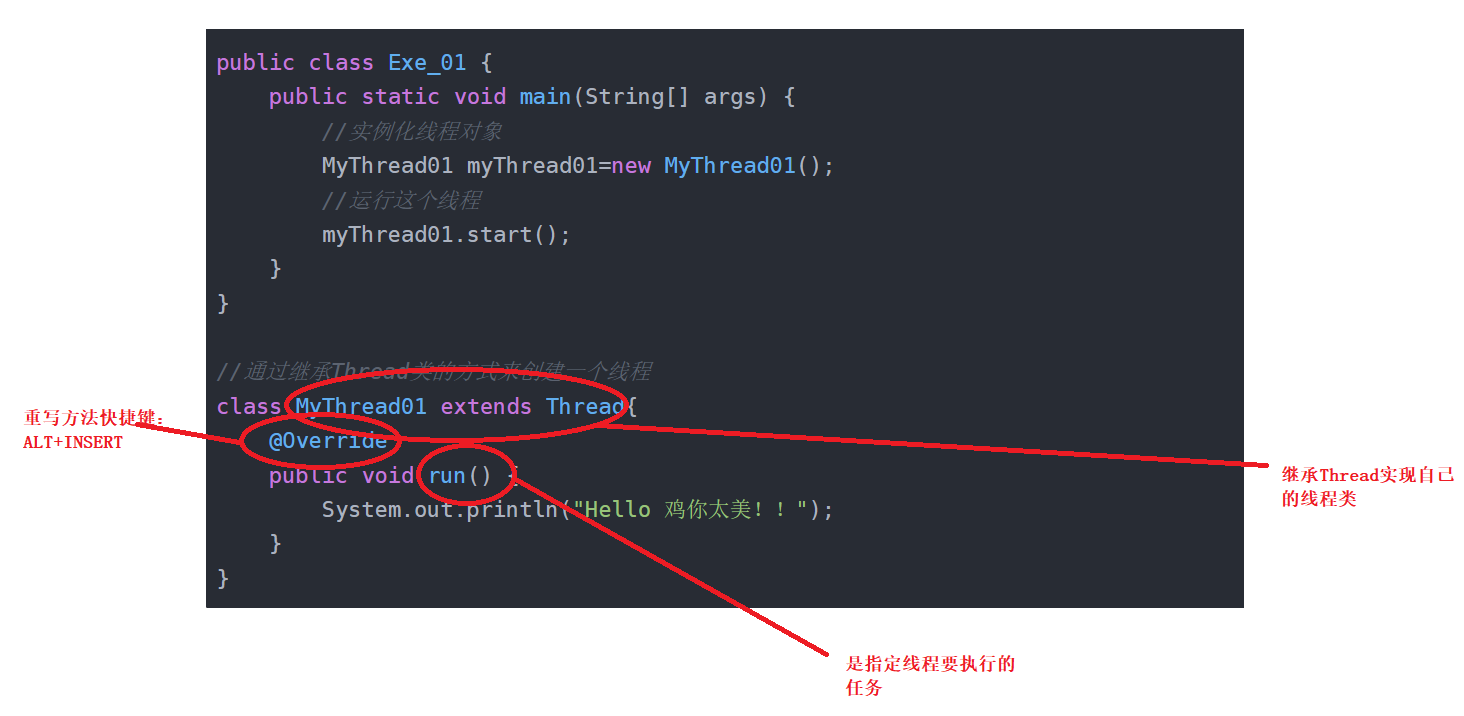
观察线程调度:
public class Exe_02 {public static void main(String[] args) {//实例化线程对象MyThread02 myThread02=new MyThread02();//真正去操作系统中申请线程并参与CPU调度myThread02.start();//在主线程也做一个死循环打印while(true){System.out.println("唱跳,rap,篮球");try {Thread.sleep(1000);} catch (InterruptedException e) {e.printStackTrace();}}}
}class MyThread02 extends Thread{//定义线程要执行的任务@Overridepublic void run() {//在一个死循环中做打印while(true){System.out.println("哎呦,你干嘛!!");try {Thread.sleep(1000);} catch (InterruptedException e) {e.printStackTrace();}}}
}运行结果:


方法二:实现Runnable接口
public class Exe_03 {//通过实现Runnable的方式创建线程public static void main(String[] args) {//实例化自定义线程类MyRunnable runnable=new MyRunnable();//通过Thread的构造方法把Runnable作为参数传入Thread thread=new Thread(runnable);//启动线程才是真正意义上的创建系统线程,参与CPU调度thread.start();}
}//实现Runnable接口
class MyRunnable implements Runnable{//定义线程要执行的任务@Overridepublic void run() {while(true){System.out.println("年轻人,耗子为汁+1");try {Thread.sleep(1000);} catch (InterruptedException e) {e.printStackTrace();}}}
}运行结果:
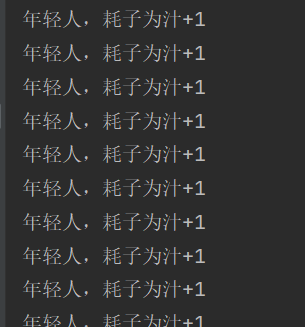
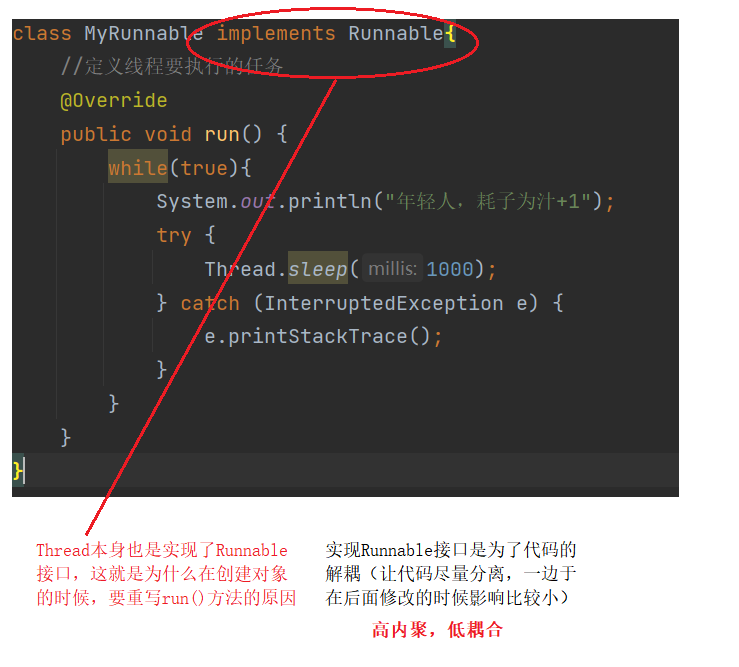
由我来给大家利用线程制作一个蔡徐坤经典名场面
public class Exe_04 {public static void main(String[] args) {//练习生任务Runnable01 runnable01=new Runnable01();//第一步给大家打个招呼Thread t1=new Thread(runnable01);t1.start();//表演任务Runnable02 runnable02=new Runnable02();//第二步给介绍鸽鸽的特长Thread t2=new Thread(runnable02);t2.start();//音乐走你Runnable03 runnable03=new Runnable03();//第三步showTimeThread t3=new Thread(runnable03);t3.start();}
}//创建Runnable类
//定义一个练习两年半练习生的任务
class Runnable01 implements Runnable{@Overridepublic void run() {while (true) {System.out.println("全明星制作人们,大家好,我是一个练习时长两年半的个人练习生蔡徐坤");try {Thread.sleep(1000);} catch (InterruptedException e) {e.printStackTrace();}}}
}
//定义一个小黑子的任务
class Runnable02 implements Runnable{@Overridepublic void run() {while (true) {System.out.println("喜欢唱、条、rap、篮球");try {Thread.sleep(1000);} catch (InterruptedException e) {e.printStackTrace();}}}
}
//点一首music送给鸽鸽
class Runnable03 implements Runnable{@Overridepublic void run() {while (true) {System.out.println("music");try {Thread.sleep(1000);} catch (InterruptedException e) {e.printStackTrace();}}}
}运行结果:

通过Thread类的匿名内部类的方式创建线程
/*
通过Thread类的匿名内部类的方式创建线程*/
public class Exe_5 {public static void main(String[] args) {Thread thread=new Thread(){public void run(){while (true) {System.out.println("通过创建Thread类的匿名内部类的方式创建线程");try {Thread.sleep(1000);} catch (InterruptedException e) {throw new RuntimeException(e);}}}};thread.start();}
}运行结果:
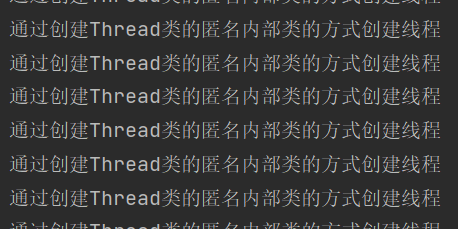
通过创建实现了Runnable接口的匿名内部类的方式创建线程
/*
通过创建实现了Runnable接口的匿名内部类的方式创建线程*/
public class Exe_06 {public static void main(String[] args) {Thread thread=new Thread(new Runnable() {@Overridepublic void run() {int count = 0;while(true) {System.out.println("通过创建实现了Runnable接口的匿名内部类的方式创建线程" + count++);try {Thread.sleep(1000);} catch (InterruptedException e) {throw new RuntimeException(e);}}}});//启动线程thread.start();}
}
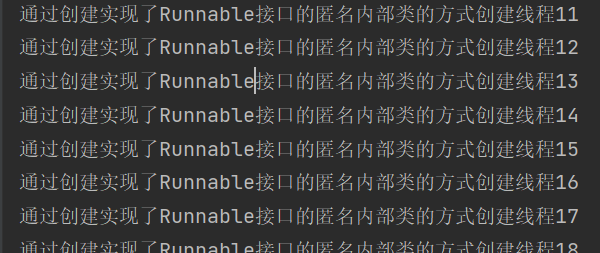
对比:上面两种方法
继承Thread,直接使用this就表示当前线程的引用。
实现Runnable接口,this表示的是MyRunnbale的引用,需要使用Thread类来调用
3、通过lambda的方式创建线程
public class Exe_07 {public static void main(String[] args) {Thread thread=new Thread(()-> {int count=0;while(true){count++;System.out.println("通过lambda表达式的方式创建一个线程"+count);try {Thread.sleep(1000);} catch (InterruptedException e) {throw new RuntimeException(e);}}});//启动线程thread.start();}
}

2、多线程的优势
多线程的优势--增加运行速度
多线程就是为了能够充分的利用CPU的资源,提升程序运行效率。
需求场景:
分别对两个变量做累加100亿次操作
一种是单线程执行,一种是两条线程并发操作。
/*多线程的优势-增加运行速度
分别对两个变量做100亿次累加操作*/
public class Exe_08 {private static long count=10_0000_0000l;public static void main(String[] args) {//串行方式serial();//并行方式concurrency();}private static void concurrency() {//记录开始时间long begin=System.currentTimeMillis();//创建线程,在单个线程中执行对一个变量的累加Thread t1=new Thread(()->{long a=0l;for (int i = 0; i < count; i++) {a++;}});Thread t2=new Thread(()->{long b=0l;for (int i = 0; i < count; i++) {b++;}});//启动线程t1.start();t2.start();//等待try {t1.join();t2.join();} catch (InterruptedException e) {throw new RuntimeException(e);}//记录结束时间long end=System.currentTimeMillis();System.out.println("并行操作用时:"+(end-begin)+"ms.");}private static void serial(){//记录开始时间long begin=System.currentTimeMillis();long a=0l;//对变量进行累加for (int i = 0; i < count; i++) {a++;}long b=0l;for (int i = 0; i < count; i++) {b++;}//累加完成之后记录结束时间long end=System.currentTimeMillis();System.out.println("串行操作用时:"+(end-begin)+"ms.");}
}运行结果:
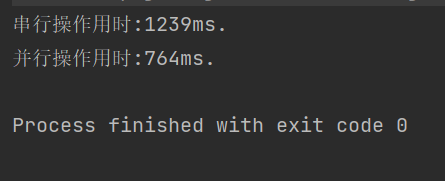
结论:多线程的使用可以明显的提高程序的运行效率,充分利用CPU的资源。





